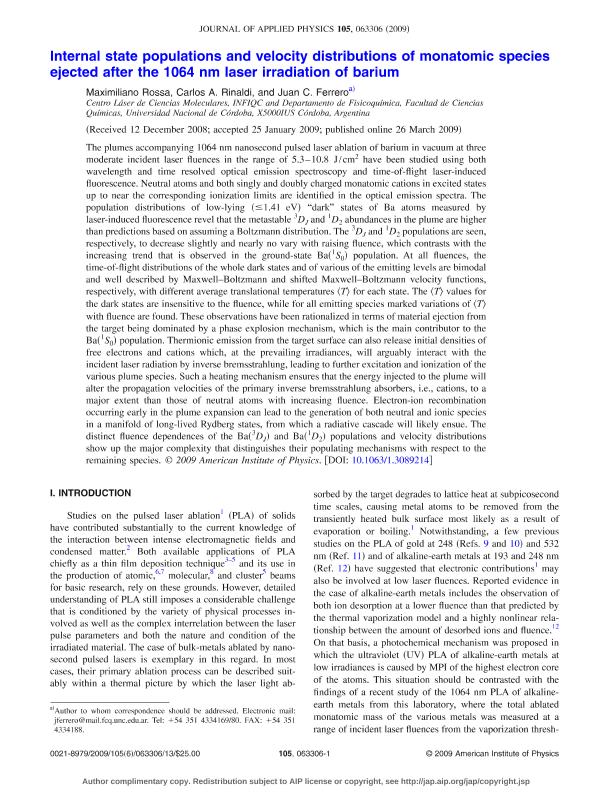Mostrar el registro sencillo del ítem
dc.contributor.author
Rossa, Maximiliano

dc.contributor.author
Rinaldi, Carlos Alberto

dc.contributor.author
Ferrero, Juan Carlos

dc.date.available
2019-09-03T17:47:19Z
dc.date.issued
2009-12
dc.identifier.citation
Rossa, Maximiliano; Rinaldi, Carlos Alberto; Ferrero, Juan Carlos; Internal state populations and velocity distributions of monatomic species ejected after the 1064 nm laser irradiation of barium; American Institute of Physics; Journal of Applied Physics; 105; 6; 12-2009
dc.identifier.issn
0021-8979
dc.identifier.uri
http://hdl.handle.net/11336/82799
dc.description.abstract
The plumes accompanying 1064 nm nanosecond pulsed laser ablation of barium in vacuum at three moderate incident laser fluences in the range of 5.3-10.8 J/ cm2 have been studied using both wavelength and time resolved optical emission spectroscopy and time-of-flight laser-induced fluorescence. Neutral atoms and both singly and doubly charged monatomic cations in excited states up to near the corresponding ionization limits are identified in the optical emission spectra. The population distributions of low-lying (≤1.41 eV) "dark" states of Ba atoms measured by laser-induced fluorescence revel that the metastable 3DJ and 1D2 abundances in the plume are higher than predictions based on assuming a Boltzmann distribution. The 3DJ and 1D 2 populations are seen, respectively, to decrease slightly and nearly no vary with raising fluence, which contrasts with the increasing trend that is observed in the ground-state Ba(1S3DJ and 1D0) population. At all fluences, the time-of-flight distributions of the whole dark states and of various of the emitting levels are bimodal and well described by Maxwell-Boltzmann and shifted Maxwell-Boltzmann velocity functions, respectively, with different average translational temperatures 〈T〉 for each state. The 〈T〉 values for the dark states are insensitive to the fluence, while for all emitting species marked variations of 〈T〉 with fluence are found. These observations have been rationalized in terms of material ejection from the target being dominated by a phase explosion mechanism, which is the main contributor to the Ba ( 1S3DJ and 1D0) population. Thermionic emission from the target surface can also release initial densities of free electrons and cations which, at the prevailing irradiances, will arguably interact with the incident laser radiation by inverse bremsstrahlung, leading to further excitation and ionization of the various plume species. Such a heating mechanism ensures that the energy injected to the plume will alter the propagation velocities of the primary inverse bremsstrahlung absorbers, i.e., cations, to a major extent than those of neutral atoms with increasing fluence. Electron-ion recombination occurring early in the plume expansion can lead to the generation of both neutral and ionic species in a manifold of long-lived Rydberg states, from which a radiative cascade will likely ensue. The distinct fluence dependences of the Ba(3D 3DJ and 1DJ) and Ba( 113DJ and 1D2) populations and velocity distributions show up the major complexity that distinguishes their populating mechanisms with respect to the remaining species.
dc.format
application/pdf
dc.language.iso
eng
dc.publisher
American Institute of Physics

dc.rights
info:eu-repo/semantics/openAccess
dc.rights.uri
https://creativecommons.org/licenses/by-nc-sa/2.5/ar/
dc.subject
Laser Ablation
dc.subject
Internal State Population Distributions
dc.subject
Velocity Distributions
dc.subject
Laser Induced Fluorescence
dc.subject.classification
Físico-Química, Ciencia de los Polímeros, Electroquímica

dc.subject.classification
Ciencias Químicas

dc.subject.classification
CIENCIAS NATURALES Y EXACTAS

dc.title
Internal state populations and velocity distributions of monatomic species ejected after the 1064 nm laser irradiation of barium
dc.type
info:eu-repo/semantics/article
dc.type
info:ar-repo/semantics/artículo
dc.type
info:eu-repo/semantics/publishedVersion
dc.date.updated
2019-03-18T15:06:04Z
dc.identifier.eissn
1089-7550
dc.journal.volume
105
dc.journal.number
6
dc.journal.pais
Estados Unidos

dc.description.fil
Fil: Rossa, Maximiliano. Consejo Nacional de Investigaciones Científicas y Técnicas. Centro Científico Tecnológico Conicet - Córdoba. Instituto de Investigaciones en Físico-química de Córdoba. Universidad Nacional de Córdoba. Facultad de Ciencias Químicas. Instituto de Investigaciones en Físico-química de Córdoba; Argentina
dc.description.fil
Fil: Rinaldi, Carlos Alberto. Consejo Nacional de Investigaciones Científicas y Técnicas. Centro Científico Tecnológico Conicet - Córdoba. Instituto de Investigaciones en Físico-química de Córdoba. Universidad Nacional de Córdoba. Facultad de Ciencias Químicas. Instituto de Investigaciones en Físico-química de Córdoba; Argentina
dc.description.fil
Fil: Ferrero, Juan Carlos. Consejo Nacional de Investigaciones Científicas y Técnicas. Centro Científico Tecnológico Conicet - Córdoba. Instituto de Investigaciones en Físico-química de Córdoba. Universidad Nacional de Córdoba. Facultad de Ciencias Químicas. Instituto de Investigaciones en Físico-química de Córdoba; Argentina
dc.journal.title
Journal of Applied Physics

dc.relation.alternativeid
info:eu-repo/semantics/altIdentifier/url/https://aip.scitation.org/doi/10.1063/1.3089214
dc.relation.alternativeid
info:eu-repo/semantics/altIdentifier/doi/http://dx.doi.org/10.1063/1.3089214
Archivos asociados
